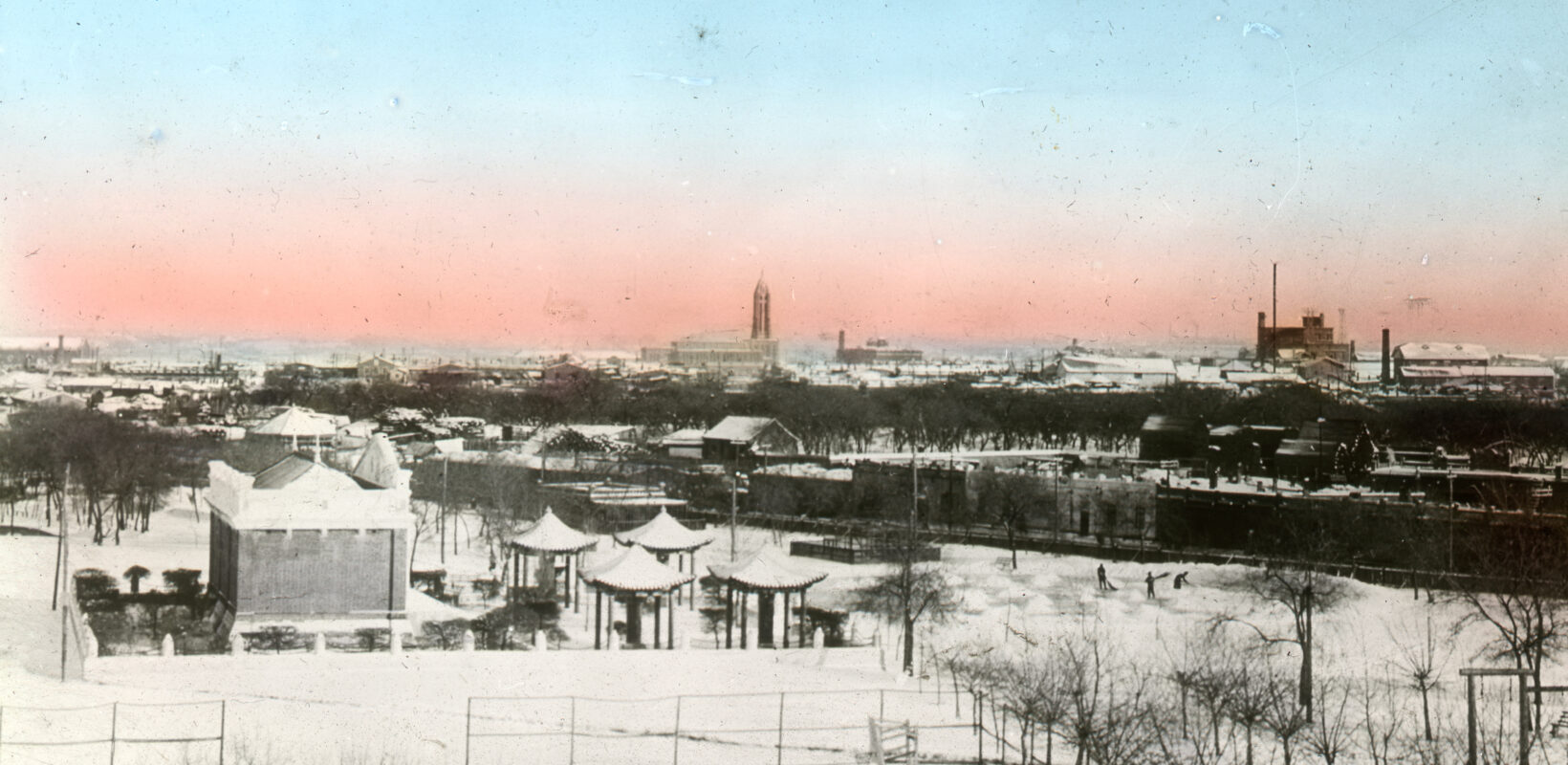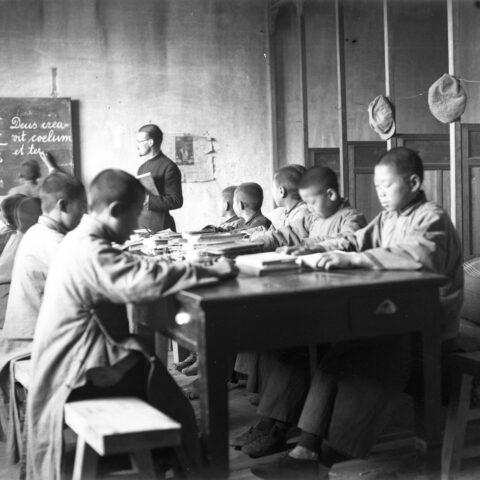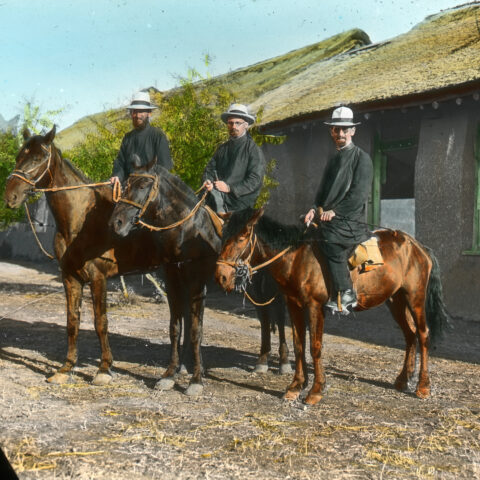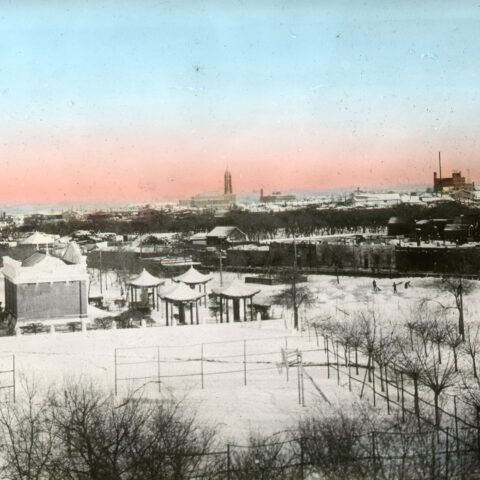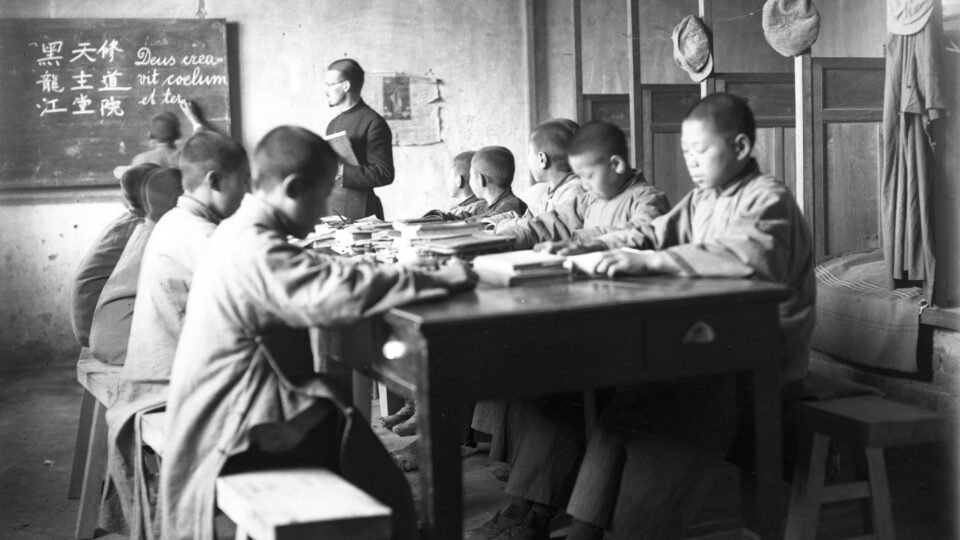The Bethlehem Mission Society (Latin: Societas Missionum Exterarum de Bethlehem in Helvetia; abbreviation of the Society: SMB) is a Society of Apostolic Life comprising priests and brothers who have joined together for missionary service.
The Bethlehem Mission Society (Latin: Societas Missionum Exterarum de Bethlehem in Helvetia; abbreviation of the Society: SMB) is a Society of Apostolic Life comprising priests and brothers who have joined together for missionary service. As a Society of Apostolic Life, the Bethlehem Mission Society is not a religious order and is directly subordinate to the Dicastery for Evangelization in Rome. The members of the Mission Society lead a life according to the evangelical counsels, i.e. poverty, obedience, and celibacy.
The history of the origins
The origins of the Bethlehem Mission Society go back to the French priest Pierre-Marie Barral. In 1895, he founded the “Ecole apostolique de Bethléem” (Apostolic School of Bethlehem) in Meggen, Switzerland, which was moved to Immensee in 1896. It became the Gymnasium Bethlehem, Immensee (Bethlehem grammar school/high school). In the same year, the first issue of the multilingual monthly magazine “Bethlehem” appeared, which was published under the name “Wendekreis” from 1972 until 2017.
While the institute originally aimed to train the sons of poor families for missionary service in Europe’s abandoned parishes, missionary activities in Asia, Africa and Latin America were developed over time. Circles of friends were formed in Austria, Italy, France, Great Britain, Portugal, and the USA. Difficulties in the work, which was financed through stamp trading, dishonest fundraising, and loans, led to a reorganization as the Bethlehem Mission House in 1907 by the later first Superior General Pietro Bondolfi.
On 30th May, 1921, the papal decree establishing the “Swiss Seminary for Foreign Missions” was issued in Rome. Pietro Bondolfi was the first Superior General. From 1934, the association was called the “Society for Foreign Missions of Bethlehem in Switzerland” (Societas Missionaria de Bethlehem in Helvetia). For short, it is known as the Bethlehem Mission Society (SMB).
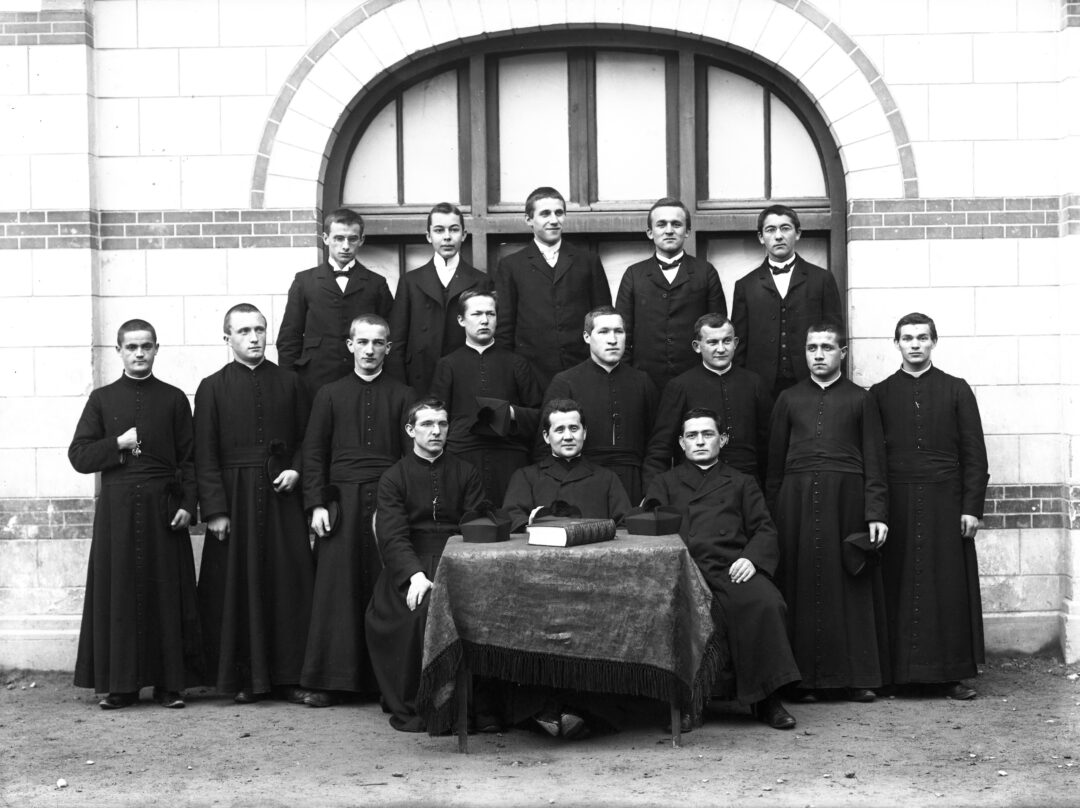
Students of the philosophy class from Pietro Bondolfi (front, centre) around 1910 (SMB archive, FDC 115/22)
Most of the new members of the Society were recruited from the Gymnasium Bethlehem (Bethlehem grammar school) run for this purpose in Immensee. This included the “Progymnasium” (lower Forms) in Rebstein (1926–73) and Fribourg (1938–72). In 1995, the grammar school/high school was transferred to a private foundation under the name of “Gymnasium Immensee”.
The training of candidates for the priesthood began in 1922 at the seminary in Wolhusen, was then transferred to the “Bruder-Klausen-Seminar” (Seminary of St. Nicholas of Flüe) in Schöneck (Emmetten) in 1932, and has taken place at the Faculty of Theology in Lucerne since 1969.
In 1925, the first Brother missionaries were admitted into the SMB to work in administration, schools, businesses, and agriculture. The Brothers, as well as the candidates for the priesthood and the priests, pledge to live according to the principles of the SMB.
Research into missions and religious studies became a focal point in 1945 with the founding of the “Neue Zeitschrift für Missionswissenschaft” (NZM – New Journal for Missiology), which was replaced by the “Forum Mission” yearbook in 2005.
The first country: China
Already in 1924 the first three missionaries travelled to China where they were first with the Steyler Missionaries in Yanzhou, South-Shandong to learn the Chinese language and culture. In July 1925 the Apostolic Delegate, Celso Costantini, gave them their own mission area – the Apostolic Prefecture Qiqihar in the far north of China.
On the 19th. March 1926 Paul Hugentobler und Eugen Imhof arrived in Qiqihar, while Gustav Schnetzler took over the village of Changfatun. The SMB devoted themselves to the establishment of the local Christian community and together with the Ingenbohl Sisters to the building up of medical care and school education. By 1940 there were 42 SMB priests active in China. In 1953 most of them were expelled with the last leaving China in 1954.
From mission territories to missionary assignments
In 1938 the SMB began their work in the former Southern Rhodesia, now Zimbabwe. At times well over 100 members were engaged in the development of the local church, in education and medical fields, in the media and in handwork training.
In 1948 the SMB sent the first missionaries to Iwate-ken in North Japan. In the same year the SMB began the first engagement with lay missionaries in former Fort Victoria, now Masvingo, in Southern Rhodesia. After the expulsion of the last missionaries from China, in 1953, the SMB began their work in Taiwan und Columbia.
In 1975 group work began in Peru, 1977 in Ecuador, 1978 in Kenya und 1985 in the Philippines. At the General Chapter in 1981, “Integral Liberation” was formulated with the following three options:
- options for and with the poor,
- engagement for human rights and
- building up basic communities.
In 1992 the SMB began their first missionary engagement in Bolivia.
Setting the course for the future
In 1993 the General Chapter formulated a basic declaration regarding missionary presence with the ideal: “What we are says more than what we say”.
In 1994 the SMB appeared in public under the publicity title “Bethlehem Mission Immensee”. (SMB)
The Bethlehem Mission Society (SMB) has long has its headquarters in Immensee. Through its leadership and administration it supports its missionary engagement in Asia (Taiwan, Japan), in Africa (Zimbabwe, Moçambique, Kenya, Tansania), in Latin America (Columbia) und Europa (Switzerland, Germany).
The main emphasis of the 12th regular General Chapter in 2013 was, amongst other things, a model, a document with the title “Some of us are growing ever older“, the future of the SMB as a mission society and building projects which need to be considered because of buildings becoming empty and usable plots of land at hand. The foundation stone for the “Living in Bethlehem” housing project was also laid at this General Chapter.
The next mission: “Living in Bethlehem”
The SMB owns several buildings and properties, most of which were donated to the Mission Society by private individuals.
In 2013, the SMB decided to build a multi-generational settlement on its property near the motherhouse in Immensee. “Living in Bethlehem” is being realized by the Bethlehem Mission House Association in four stages, presumably until 2037 [20]. After eight years of planning and implementation, tenants were able to move into the 51 apartments of the first stage in 2021 [21]. Spread over three construction phases, more than 100 additional apartments are to be built by 2037. A total of around 180 apartments will be realized in the twelve new buildings.
The new settlement stands for communal living and offers its residents additional services such as support in everyday life, childcare, and common rooms. With the project, the Mission Society responded to the local need for affordable housing in the Küssnacht district, especially for families and seniors. At the same time, the SMB and the district used the project to advance the development of opportunities in the area of living in old age. A declaration of intent was also signed with the BSZ Foundation in Seewen and Viva Group AG in Lucerne in 2022 to clarify the implementation of a joint project in more detail.
Participation of laypersons
As a result of the upgrading of the laity in missionary and church service through the Second Vatican Council, together with a new understanding of mission, an increasing number of lay people worked with the SMB in projects. The first mixed engagement of lay people and priests in team-work came into being. The SMB General Chapter of 1967 anchored “Working towards replacement” in its documents. They no longer took over areas allotted to them (territorial principal), but began with project assignments for a limited period. The first of this type of project began in Zambia in 1969.
Das General Chapter of 1974 confirmed such project engagements as a new form of missionary work. The following main motives were formulated:
- the essential union of mission and development cooperation;
- the partnership with the local Church; basic ecumenical orientation.
The General Chapter of 1998 confirmed the options of 1981 and strengthened them through emphasising the equal position of women. The SMB gave the men and women linked to them the opportunity to organise themselves in the “Association” and to take part in missionary assignments.
Expansion of ownership
The general Chapter of 1998 was aware of the changes of mission personnel and prepared a model to include additional carriers. The basic options were:
- Proclaiming the God of life
- Engagement with and for the under privileged
- Intercultural and interreligious dialogue
On July 30th 2000 the Association was changed to the “Partner Organisation Bethlehem”. (PaV). November 17th 2000 is the foundation day of the organisation “Bethlehem Mission Immensee” (BMI) according to article 60ff of the Swiss Civil Law Book. The name for the organisation, “Bethlehem Mission Immensee” is the name used since 1994 as the information title of the SMB. The carriers of the new organisation were the Organisation Missionshaus Bethlehem which represents the Bethlehem Mission Society according to civil law, and the Partner Organisation (PaV). This meant that the missionary commitment of the SMB could now be carried by supporting carriers with the aim that lay people and SMB members have equal rights and can decide together in partnership the planning and realisation of missionary commitments.
At the 11th regular General Chapter of the SMB in 2008, the model of both carriers of Bethlehem Mission Immensee was accepted in a positive way as united and equal carriers.
Shared values – individual paths
On June 25th 2011 the partnership structure of the organisation “Bethlehem Mission Immensee” (BMI) came to an end through a decision made at the Annual General Meeting. Through this decision, the Partner Organisation ceased to be a carrier of the activities of “Bethlehem Mission Immensee” and the Bethlehem Mission Society stayed as it was before the year 2000.
Under the same name, “Bethlehem Mission Immensee“, an organisation was founded on the same day that is legally, administrative and financially independent from the Bethlehem Mission Society and is an autonomous non-government organisation (NGO).
In the summer of 2013, “Bethlehem Mission Immensee” ( BMI) moved its headquarters to Romero House in Lucerne which it bought from the SMB.
What binds the SMB and the BMI together?
The BMI works in the Alliance COMUNDO closely together with the development welfare organisation Inter-Agire (Italian-speaking Switzerland). Today both organisations – the SMB and COMUNDO – exist alongside one another and work for the shared vision of a better and fairer world – each in its own specific way. Priests und brothers of the SMB, as also members of the BMI engage in projects, live and work in the countries of the global south in support of people affected by poverty and discrimination.
The Superior General of the SMB, the President of the Association Missionshaus Bethlehem, the Chairman of the board of Comundo and the CEO of Comundo meet for regular discussions. In these meetings actual questions are discussed, propositions are prepared to be handled by the deciding body and information is exchanged.
further information
The SMB turns 100 years old
With the completion of the first phase of “Wohnen im Bethlehem” («Living in Bethlehem») and the upcoming milestone birthday at the end of 2019, the missionary organisation is giving itself a new look and a new name: The symbol consisting of four hearts stands for the diverse work and endeavours of the Mission Society:



- One heart denotes the SMB, which with the name “Bethlehem” stands for the incarnation of Jesus in the sense of being a fellow human being.
- One heart stands for the Mission Society, which is committed to serving the poor, disadvantaged and marginalised.
- One heart symbolises the attentive exchange and the respectful cooperation with people of other cultures and religions.
- One heart symbolises the housing estate being built in Immensee and its impact on the surrounding area.
The end of May 2021 marks the 100th anniversary of the papal decree. Due to the coronavirus pandemic, the three-day celebrations were postponed by one year to the weekend of 6th to 8th May 2022.

